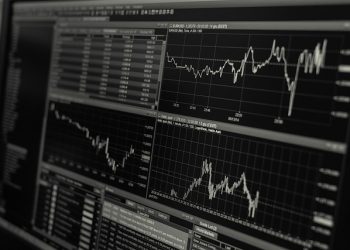Stocks ended higher on Friday, with the S&P 500 and Nasdaq closing out the session at record levels.
The S&P 500 and Nasdaq each rose about 0.5 %, even though the Dow concluded simply a tick above the flatline. U.S. stocks shook off earlier declines after tracking a drop in overseas equities, after new data showed that UK gross domestic product (GDP) slumped by a record 9.9 % in 2020 as a virus induced recession swept the country.
Shares of Dow component Disney (DIS) reversed earlier benefits to fall greater than 1 % and pull back from a record extremely high, after the company posted a surprise quarterly profit and cultivated Disney+ streaming subscribers much more than expected. Newly public organization Bumble (BMBL), which started trading on the Nasdaq on Thursday, rose another 7 % after jumping sixty three % in its public debut.
Over the older couple weeks, investors have absorbed a bevy of stronger than expected earnings results, with company earnings rebounding much faster than expected regardless of the ongoing pandemic. With over eighty % of businesses right now having reported fourth-quarter results, S&P 500 earnings per share (EPS) have topped estimates by 17 % for aggregate, and bounced back above pre-COVID amounts, based on an analysis by Credit Suisse analyst Jonathan Golub.
generous government action and “Prompt mitigated the [virus related] damage, leading to outsized economic and earnings surprises,” Golub said. “The earnings recovery has been considerably more effective than we could have imagined when the pandemic first took hold.”
Stocks have continued to set new record highs against this backdrop, and as fiscal and monetary policy assistance remain strong. But as investors come to be accustomed to firming corporate functionality, companies might need to top greater expectations in order to be rewarded. This could in turn put some pressure on the broader market in the near term, and also warrant much more astute assessments of specific stocks, in accordance with some strategists.
“It is actually no secret that S&P 500 performance has been extremely powerful over the past several calendar years, driven largely via valuation expansion. However, with the index P/E [price-to-earnings ratio] recently eclipsing its prior dot-com high, we think that valuation multiples will begin to compress in the coming months,” BMO Capital Markets strategist Brian Belski wrote in a note Thursday. “According to our job, strong EPS growth will be important for the following leg higher. Fortunately, that’s precisely what present expectations are forecasting. Nonetheless, we also found that these types of’ EPS-driven’ periods tend to be more complicated from an investment strategy standpoint.”
“We believe that the’ easy money days’ are actually more than for the time being and investors will have to tighten up the focus of theirs by evaluating the merits of specific stocks, as opposed to chasing the momentum laden methods that have just recently dominated the expense landscape,” he added.
–
4:00 p.m. ET: Stocks end higher, S&P 500 and Nasdaq reach record closing highs
Here is where the major stock indexes ended the session:
S&P 500 (GSPC): +18.55 points (+0.47 %) to 3,934.93
Dow (DJI): +27.44 points (+0.09 %) to 31,458.14
Nasdaq (IXIC): +69.70 points (+0.5 %) to 14,095.47
–
2:58 p.m. ET:’ Climate change’ would be the most cited Biden policy on corporate earnings calls: FactSet
Fourth-quarter earnings season marks the pioneer with President Joe Biden in the White House, bringing the latest political backdrop for corporations to contemplate.
Biden’s policies around climate change as well as environmental protections have been the most-cited political issues brought up on company earnings calls up to this point, according to an analysis from FactSet’s John Butters.
“In terms of government policies discussed in conjunction with the Biden administration, climate change and energy policy (twenty eight), tax policy (twenty COVID-19 and) policy (nineteen) have been cited or perhaps reviewed by the highest number of companies with this point in time in 2021,” Butters wrote. “Of these twenty eight firms, 17 expressed support (or a willingness to your workplace with) the Biden administration on policies to greatly reduce carbon as well as greenhouse gas emissions. These 17 firms both discussed initiatives to minimize their own carbon as well as greenhouse gas emissions or goods or services they supply to help customers and customers lower the carbon of theirs and greenhouse gas emissions.”
“However, four companies also expressed a number of concerns about the executive order setting up a moratorium on new engine oil and gas leases on federal lands (and also offshore),” he added.
The list of twenty eight companies discussing climate change and energy policy encompassed businesses from a diverse array of industries, like JPMorgan Chase, United Airlines Holdings and 3M, alongside conventional oil majors like Chevron.
–
11:36 a.m. ET: Stocks mixed, S&P 500 and Nasdaq turn positive
Here’s in which marketplaces were trading Friday intraday:
S&P 500 (GSPC): +7.87 points (+0.2 %) to 3,924.25
Dow (DJI): -8.77 points (0.03 %) to 31,421.93
Nasdaq (IXIC): +28.15 points (+0.21 %) to 14,053.77
Crude (CL=F): +$0.65 (+1.12 %) to $58.89 a barrel
Gold (GC=F): +$0.20 (+0.01 %) to $1,827.00 per ounce
10-year Treasury (TNX): +2.7 bps to deliver 1.185%
–
10:15 a.m. ET: Consumer sentiment unexpectedly plunges to a six-month low in February: U. Michigan
U.S. consumer sentiment slid to probably the lowest level since August in February, according to the University of Michigan’s preliminary monthly survey, as Americans’ assessments of the road ahead for the virus-stricken economy unexpectedly grew more grim.
The headline consumer sentiment index dipped to 76.2 from 79.0 in January, sharply losing out on expectations for an increase to 80.9, according to Bloomberg consensus data.
The whole loss in February was “concentrated in the Expectation Index and involving households with incomes below $75,000. Households with incomes of the bottom third reported major setbacks in their current finances, with fewer of the households mentioning recent income gains than anytime since 2014,” Richard Curtin chief economist for the university’s Surveys of Consumers, said in a statement.
“Presumably a new round of stimulus payments will reduce fiscal hardships among those with the lowest incomes. Much more surprising was the finding that customers, despite the likely passage of a large stimulus bill, viewed prospects for the national economy less favorably in early February than last month,” he added.
–
9:30 a.m. ET: Stocks open lower, but speed toward posting weekly gains
Here’s in which marketplaces had been trading simply after the opening bell:
S&P 500 (GSPC): 8.31 points (0.21 %) to 3,908.07
Dow (DJI): 19.64 (0.06 %) to 31,411.06
Nasdaq (IXIC): -53.51 (+0.41 %) to 13,970.45
Crude (CL=F): 1dolar1 0.23 (0.39 %) to $58.01 a barrel
Gold (GC=F): -1dolar1 10.70 (0.59 %) to $1,816.10 per ounce
10-year Treasury (TNX): +3.2 bps to yield 1.19%
–
9:05 a.m. ET: Equity funds see highest weekly inflows actually as investors pile into tech stocks: Bank of America
Stock funds just saw the largest ever week of theirs of inflows for the period ended February 10, with inflows totaling a record $58.1 billion, based on Bank of America. Investors pulled a total of $800 million out of gold and $10.6 billion out of money throughout the week, the firm added.
Tech stocks in turn saw their very own record week of inflows during $5.4 billion. U.S. large cap stocks saw the second-largest week of theirs of inflows ever at $25.1 billion, and U.S. tiny cap inflows saw their third largest week at $5.6 billion.
Bank of America warned that frothiness is actually rising in markets, nevertheless, as investors keep on piling into stocks amid low interest rates, along with hopes of a strong recovery for corporate profits and the economy. The firm’s proprietary “Bull and Bear Indicator” monitoring market sentiment rose to 7.7 from 7.5, nearing an 8.0 “sell” signal.
–
7:14 a.m. ET Friday: Stock futures point to a lower open
Below had been the principle moves in markets, as of 7:16 a.m. ET Friday:
S&P 500 futures (ES=F): 3,904.00, printed 8.00 points or even 0.2%
Dow futures (YM=F): 31,305.00, down fifty four points or 0.17%
Nasdaq futures (NQ=F): 13,711.25, down 17.75 points or even 0.13%
Crude (CL=F): 1dolar1 0.43 (-0.74 %) to $57.81 a barrel
Gold (GC=F): -1dolar1 9.50 (0.52 %) to $1,817.30 per ounce
10-year Treasury (TNX): +0.5 bps to deliver 1.163%
–
6:03 p.m. ET Thursday: Stock futures tick higher
Here is in which marketplaces had been trading Thursday as overnight trading kicked off:
S&P 500 futures (ES=F): 3,904.50, down 7.5 points or perhaps 0.19%
Dow futures (YM=F): 31,327.00, down 32 points or even 0.1%
Nasdaq futures (NQ=F): 13,703.5, down 25.5 points or even 0.19%

